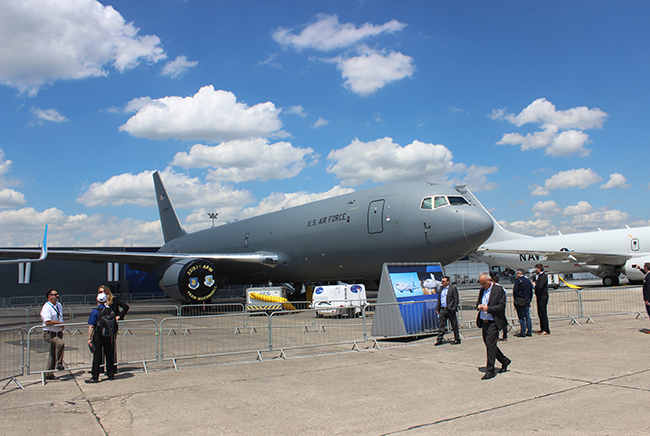
A KC-46 from McConnell AFB, Kan., sits on the flight line at the Paris Air Show on June 17. The aircraft made its air show debut, serving as a static display. Staff photo by Brian Everstine.
LE BOURGET, France—The Air Force is still finding foreign object debris inside new KC-46s, with the most recent items discovered this past week, even as it continues its “cultural dialogue” with Boeing to address the company’s response to FOD inside the tankers, Will Roper, the Air Force’s assistant secretary for acquisition, said June 17.
The KC-46 made its airshow debut at the world’s largest show here, with a KC-46 from the 344th Refueling Squadron at McConnell AFB, Kan., providing a static display on the flight line.
During a briefing with reporters, Roper said the Air Force is impressed with Boeing’s response to the FOD problem, but it remains an issue to be addressed. The Air Force anticipates all KC-46s will have FOD, so every plane on the production line is being inspected “tip to tail.” If FOD is found, the inspection restarts, he said.
This has slowed the delivery process to about “one and change” per month, as opposed to the originally expected rate of three per month, Roper said. But, the Air Force is “not going to be pushing” the schedule to move faster until the debris is cleared, he emphasized.
The service has received 11 aircraft so far. All of the aircraft have been delivered to McConnell and Altus AFB, Okla., have been inspected, and have been deemed safe to fly. There are other areas of the plane, such as interior refueling fuel tanks, that are “FOD-tolerant” for the time being, meaning those aircraft can fly for training and will eventually go back to Boeing for the in-depth inspection to ensure they are completely FOD free, Roper said.
Earlier this year, the Air Force twice stopped accepting KC-46s because of debris found inside the plane. The service in April began receiving the aircraft again as Boeing put together its plan to inspect each aircraft.
Acting Air Force Secretary Matt Donovan told reporters he’s had ongoing discussions with Boeing leadership, who have admitted this is a “cultural issue” and, like many organizations that have had issues to address, the company has taken a “pause and a reset” to refocus on its safety culture.
The Air Force and Boeing are making progress on a main “category one” deficiency on the aircraft—an issue with the aircraft’s remote vision system that displays the refueling boom to the boom operator. The Air Force has delivered its parameters that the redesigned RVS system needs to meet, and Roper said he expects the Air Force to begin receiving the new system “within months.” It will then be about three to four years for the entire fleet to either have the new system installed or retrofit for aircraft that have already been produced.
Unlike the KC-135 or KC-10, the KC-46 boom operator sits at the front of the aircraft, behind the cockpit, and uses a series of cameras to get a three-dimensional view of the rear of the airplane, wingtip to wingtip, as refueling takes place. The cameras also allow the operator to see what’s going on in blackout conditions, using thermal cameras. But, there were some challenges with sunlight impairing the boom operator’s view, and the cameras also made it difficult to see if the boom was scraping a receiving aircraft, a potential problem with stealth aircraft.
As these issues are addressed, the Air Force continues to progress with the tankers it has received. McConnell recently began initial operating test and evaluation. So far, the aircraft has refueled 15 separate military aircraft, including the stealthy B-2, F-22, and F-35.